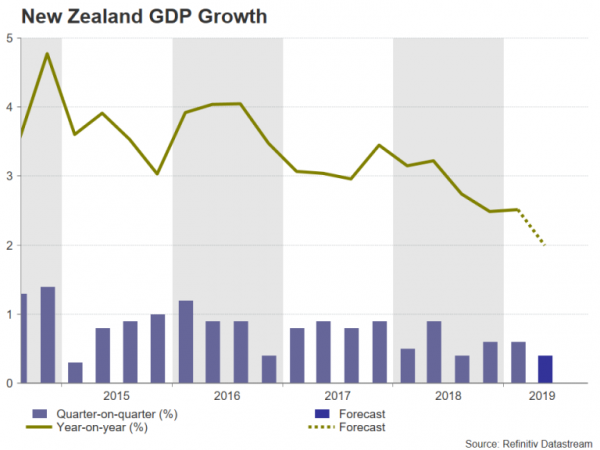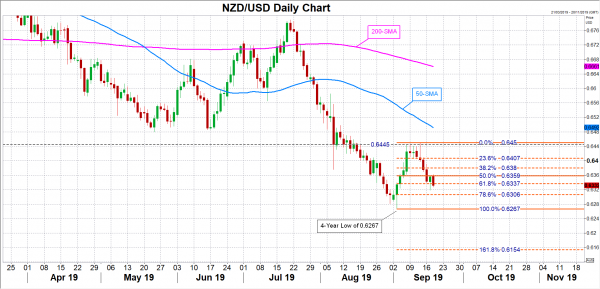New Zealand will publish GDP data on Wednesday at 22:45 GMT and expectations are that the economy slowed notably in the second quarter. The country’s central bank has already embarked on an aggressive rate cutting cycle and the data is likely to do little in paring expectations that additional policy easing will be required. A soft report would make it even more difficult for the New Zealand dollar to fight off bearish bets as the currency moves to the bottom of the performance league table for 2019.
New Zealand’s economy expected to cool further
The Reserve Bank of New Zealand (RBNZ) has been fretting about growth conditions for the past year and while the broad data hasn’t been particularly poor, the economy is growing below trend and there’s no sign of the outlook improving anytime soon. The second quarter GDP numbers are expected to confirm this picture.
The Pacific nation’s economy is forecast to have expanded by 0.4% quarter-on-quarter in the three months to June, moderating from the prior 0.6% rate. This would take the annual rate down to just 2.0%, which would be the slowest since 2013.
Gloomy outlook to blame for dovish RBNZ
While most advanced economies would be perfectly content with 2% growth, the protracted trade war has left New Zealand’s export-oriented economy highly exposed to the US-China spat. Add to that muted inflationary pressures and plunging business and consumer confidence, which have been on a downward path even before trade tensions erupted, the RBNZ’s dovish stance looks justified.
Investors seem to agree and have pushed the local dollar to four-year lows versus the US dollar. The kiwi is unlikely to escape its bearish rut unless traders begin to see the end to the RBNZ’s rate cutting cycle nearing. But with markets anticipating up to two additional rate cuts over the next 12 months, the kiwi’s fortunes aren’t about to change anytime soon, especially if the US Federal Reserve doesn’t ease policy as aggressively.
Kiwi remains bearish
The kiwi’s quick reversal in the past week of the early September rebound highlights the currency’s bearish inclination. Hence, a disappointing GDP print would fuel expectations that the RBNZ could cut rates as soon as its next meeting on September 25 and push kiwi/dollar below the 61.8% Fibonacci retracement of the September upswing to head back towards the four-year trough of 0.6267. A drop below this mark would open the way for the 161.8% Fibonacci extension at 0.6154.
However, surprisingly upbeat GDP figures could help kiwi/dollar to recover back above the 50% Fibonacci at 0.6359 and re-attempt a break above the strong resistance region of 0.6445-0.6450.















